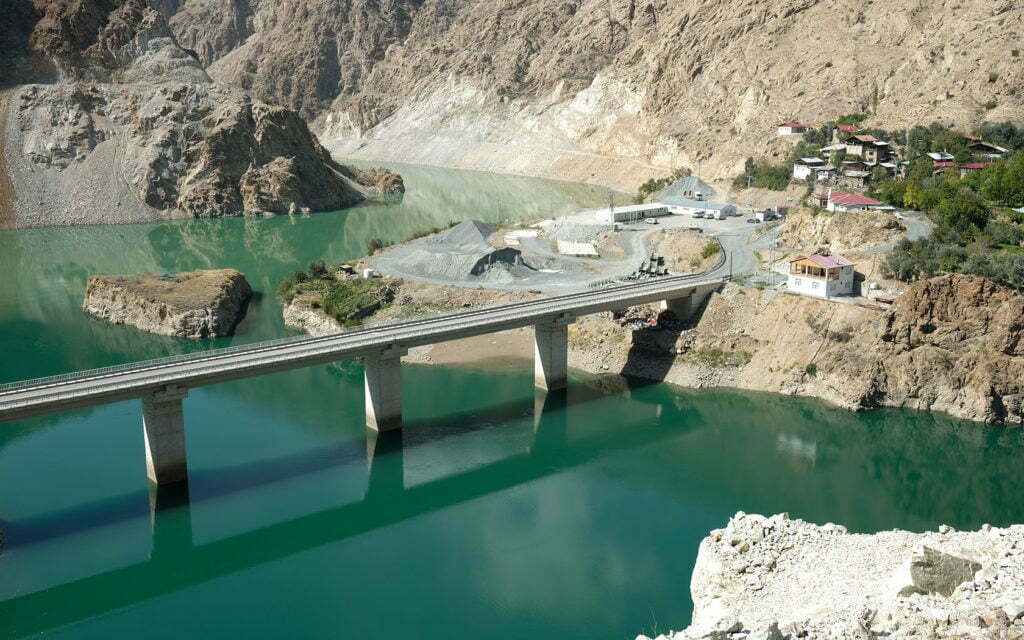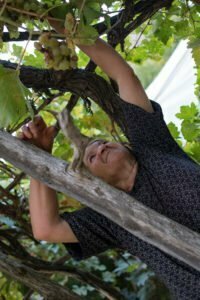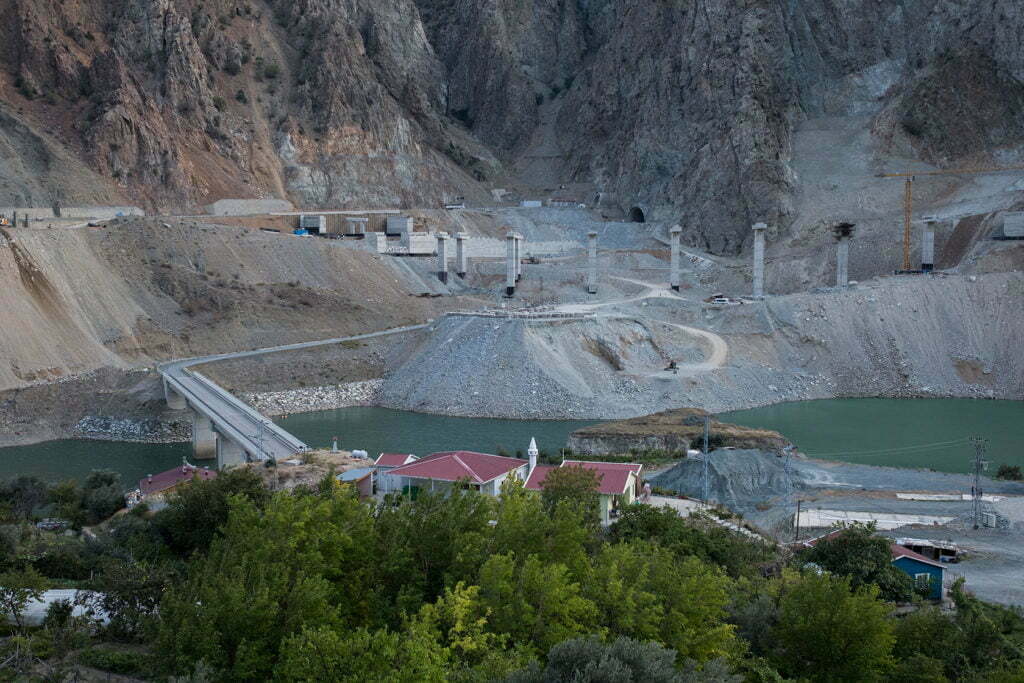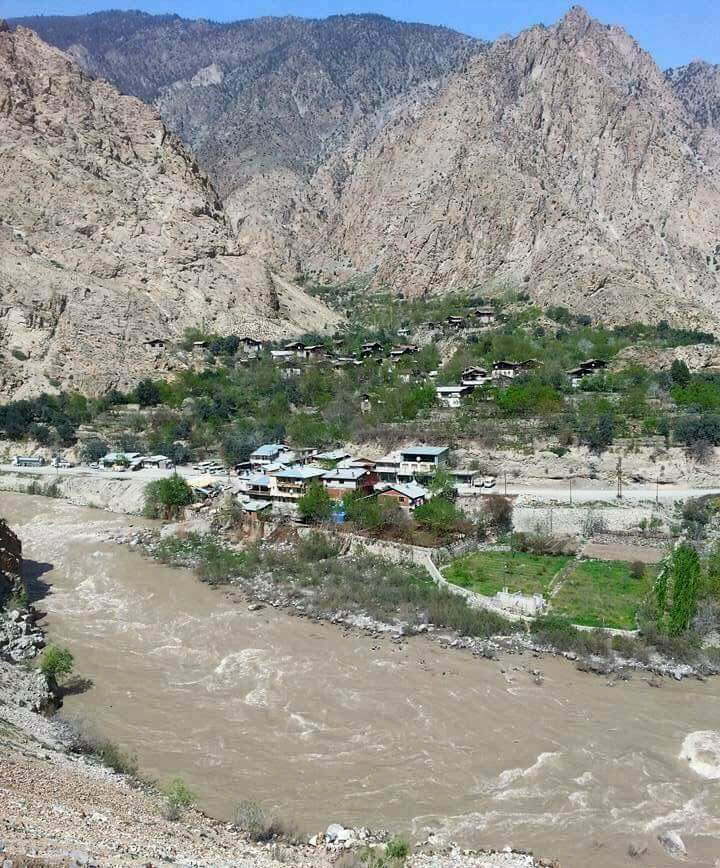VOLKAN IŞIL
Routes accompanied by water perhaps make for the most enjoyable of journeys. In journeys of this kind, seas or rivers sometimes hide behind mountains or valleys. For a minute, an ever-so-faint sense of disappointment creeps over you and you think you won’t get to see the water anymore. But just as you lose hope of seeing it again, it re-emerges with all its majesty.
The road from Artvin to Yusufeli is one of those pleasant routes where the water accompanies you – or rather, it used to be. Now, about 29 kilometers of the 67-kilometer-long new road that was constructed because of the Yusufeli Dam consists of forty tunnels of various lengths. This is a tedious, claustrophobic route where vision is clouded by the dust rising from all the new road and dam constructions along the way. Yet we still look out of the car’s windows with expectant eyes every time we exit a tunnel. The sight that confronts us, however, is bleak. In flashes and fragments, we see the villages evacuated or submerged due to the Deriner, Artvin, and Yusufeli dams, a couple of mosque minarets that jut out above the water’s surface, mostly derelict and unoccupied houses on the slopes, and the Çoruh that has turned into a sluggish stream by dam weirs. Then we go into another tunnel and a similar sight awaits us when we exit.
Just as we are about to start approaching Yusufeli, a village catches our attention at the end of a longish tunnel. One side of the village has become a construction site. Excavators are busy boring into the mountain to build a new tunnel. The mountain is weary. How can a big old mountain look weary? But it does! The mountain is apologetic. How can a big old mountain look ashamed and apologetic? Oh, but it does! You know how it is when you feel ashamed for others – that is the kind of shame this mountain has. It’s as if the mountain is no longer a mountain, and is instead like an old fellow with shoulders drooping from exhaustion, waiting for its inevitable demise. As if the mountain is lost, and is now nothing but a name. In fact, here is an entire landscape abandoned by everyone, and living only in name.

A tiny village recoiling into the mountain’s bosom greets us with its luscious green trees and vegetable gardens across a viaduct traversing the Çoruh. It’s Sebzeciler (Vegetable Growers village). We cross this viaduct to reach the village. The viaduct is like some kind of Bridge of Sirat – or purgatory; on one side is hell and on the other is heaven.

The village head Yaşar Çoruh welcomes us. He is one of the many people we have encountered with the ‘Çoruh’ surname in our journey through the Çoruh basin. Even from the surnames alone, it is possible to tell how generous the Çoruh River has been to the people of this land.
Yaşar Çoruh begins telling us the story of Sebzeciler, or Vegetable Growers village. This place too has the quality of being a microclimate, as we have seen in some other villages around Yusufeli. The village therefore has a Mediterranean climate, and this is what makes Sebzeciler what it is. Almost everyone in the village makes a living from fruit and vegetable cultivation. Yaşar Çoruh proudly underlines how olives – impossible to grow in a Black Sea climate – are cultivated here, but a short while ago this invaluable prosperity started to vanish at a rapid pace. What happened was not far from a disaster.
Here is how Yaşar Çoruh summarizes the disaster:
Our village was impacted by the Artvin Dam built by Doğuş Co. They split the village in half, and then they packed up and left. Once the construction sites were gone, what remained behind was their filth. The reservoir lake is full of trash. We can’t grow anything anymore. Two-thirds of the land was lost to the previous dam. They brought environmental pollution. The olive we used to grow is history now. The crops we cultivated have all been wasted away.
This is a landscape where everything – from fruit to vegetable, mountain to rock, soil to water, and all forms of life is wasted away: a concrete landscape that belongs to Doğuş, Limak, and Cengiz.

Yaşar Çoruh points to the viaduct before us. It stands there like the fate line on the palm of the village. Bridges join, connect and bring together; they do not divide and separate. This bridge, on the other hand, is one that separates, divides, disperses, and tears apart. It embodies the memory of how Doğuş Co. forced the villagers to make a choice between staying in or leaving the village. Everything began when a road construction site was set up in the village about a decade ago. The fate of Vegetable Growers village (Sebzeciler) was thus left in the hands of Doğuş Co. and its subcontractors.
It was around 2009-2010 that Doğuş came to our village. They set up a road construction site. They had a concrete plant. Their subcontractors had construction sites. They set an altitude of 515 m for the village and said they would buy anything that fell below this line. 515 meters corresponded to 55% of the village. So according to the protocol between Doğuş and the state, the company is responsible for everything for 45% of the village. The state says, “do everything” – and everything means connecting roads, drinking water, infrastructure, the whole deal. But since doing all of this meant incurring a high cost, the company wanted to buy the entire village instead. But it was unable to. The cost of building the viaduct at that time was 9 billion while buying the rest of the village would have cost 4 billion. In 2011 we ended up having to hold a referendum for the remaining 45% of the village. The company even interfered in local elections in the vote for village head in 2014. They brought two candidates against me. Of course, when I was re-elected, they were forced to build the viaduct. I’m in my third period in office now, it’s been 12 years. In the meanwhile, the viaduct they have built is in a dangerous state, it’s literally slipping. They also didn’t do a proper job with drinking water connections, they left them unfinished.
When there were those who persisted to stay in the village as a result of the referendum, 45% of the village was left where it was, but the village was no longer a village. It was turned into a building site, used and abused by companies, pestered with the incessant, round-the-clock din, dust, and smoke of construction. Yaşar Çoruh, on the other hand, keeps trying to resist by not giving up his local office despite all kinds of obstacles.

While our chat with the village head continues, we meet other villagers as well. A woman living in the village tells us how her husband used to work as a minibus (dolmuş) driver between Artvin and Yusufeli. While large-scale construction projects erased villages from the map one by one, they also left nobody behind to use these minibusses. This bus line therefore became one of the sources of income lost to the people of the region. Another villager speaks of how the constant construction and active building sites have compromised the village’s natural drinking water sources, which are now polluted. Yet another villager mentions suffering repeating floods after the construction of the dam. The floods and the clunky earth-moving machinery constantly moving around the place have made all the streets of the village impossible to walk in. An elderly uncle in the village says, “I can’t walk around here anymore, and I can’t go to the city either.” This beautiful village has, over the years, become a bag of woes.
Yaşar Çoruh tells us that all the dust and debris created by explosives used in road and dam constructions have settled down on the village, that the incidence of COPD caused by air pollution has been on the rise among villagers lately, and that these particles also harm crops that are being cultivated.
One of those who chose to stay behind in Sebzeciler, Teliha Çakmak, explains how everything she would deem beautiful and good about the village has become a thing of the past. Aunt Teliha takes us around the village while telling us about the changes and transformations it has suffered. We set up our cameras without pause, and start following Aunt Teliha. The more she speaks, the heavier we feel.
As soon as we get back to Istanbul, we produce a short documentary based on Aunt Teliha’s narrative that everyone reading this article should definitely watch. Perhaps it is best from this point onwards that you visit that short documentary to follow the rest of Sebzeciler’s story, and witness it for yourselves.